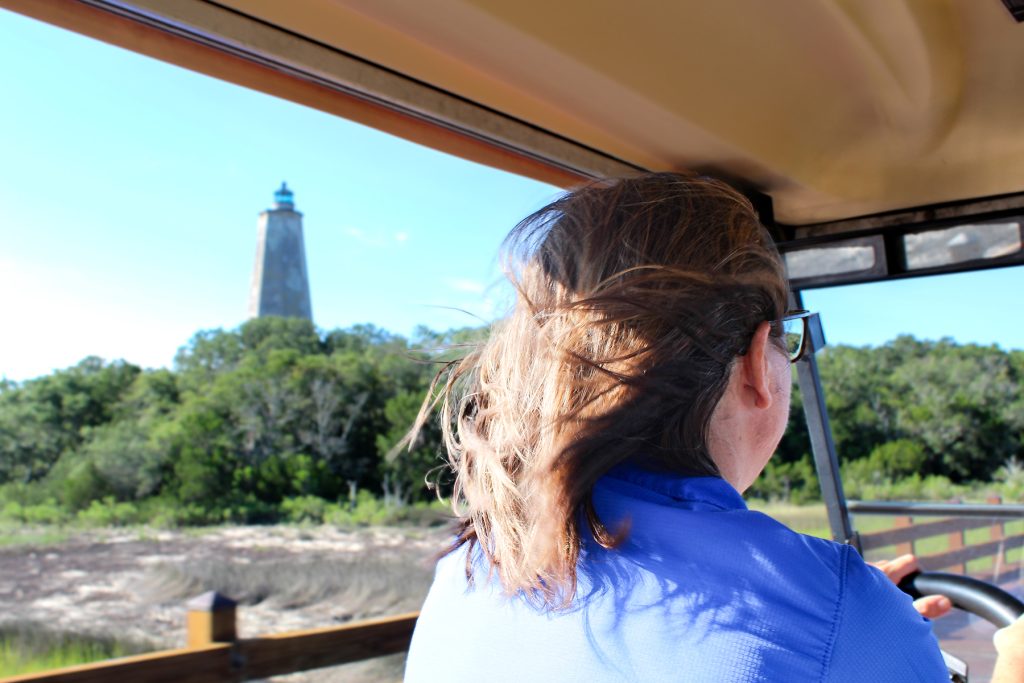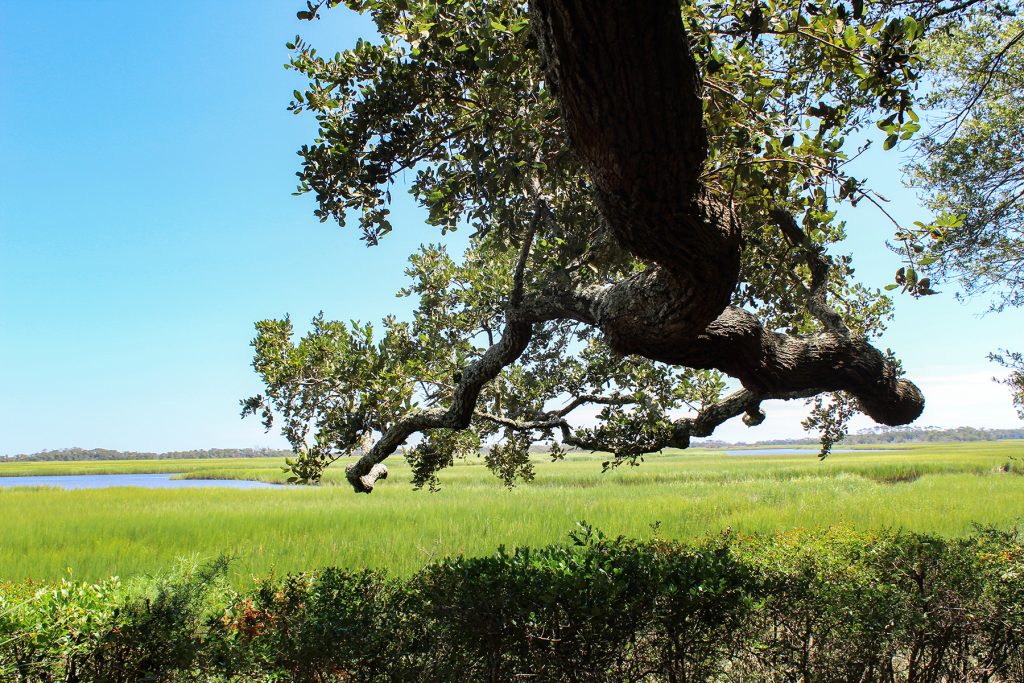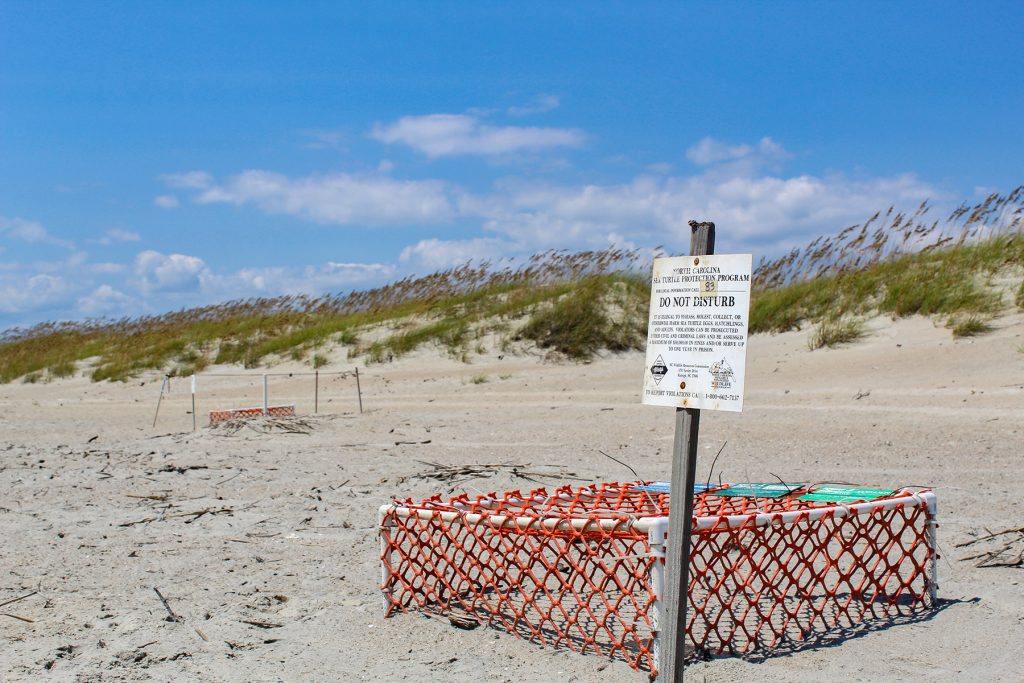
Graduate student Kimmy Hansen is analyzing the impact of future development on the tree canopy of Bald Head Island, a North Carolina barrier island that boasts the second-largest maritime forest in the state.
Summer sun shimmers on the waves as the 8 a.m. ferry leaves Southport, North Carolina, for a 20-minute journey across the Cape Fear River. As the boat reaches its destination, passengers are greeted with this welcome sign as they step onto the dock: “We share the island with wildlife. Please do not approach, feed, harass or intrude upon their habitats.”
Welcome to Bald Head Island.

UNC-Chapel Hill graduate student Kimmy Hansen is waiting at the marina, along with Beth Darrow, chief scientist for the Bald Head Island Conservancy, a 40-year-old nonprofit that champions the sustainability of the island. After a quick stop at the Sandpiper Coffee Shop, Hansen skillfully guides “Sharky” the golf cart — all of the conservancy’s golf carts have names — to begin a tour of the approximately 4-square-mile island.
Rush hour takes on a new meaning here, because no private cars are allowed. Golf carts share the roads with passenger trams, bicycles, and government and construction vehicles. The honk of car horns is replaced with the hum of cicadas. The speed limit is 18 mph and the brown street signs are placed at golf-cart level.
But the most striking thing about Bald Head Island is the abundance of trees. Live oaks, laurel oaks, sabal palmettos, cedars and more provide shade for American holly, yaupon, catbrier and other plants. Bald Head is home to the second-largest maritime forest in North Carolina. Ocean forests are immensely important in protecting shorelines from the ongoing movement of the coast.
It’s a different kind of beach town.

“I’d never studied forests before coming here, but I’ve become kind of obsessed with the forest,” Darrow said. She explained that Bald Head is part of the Smith Island Complex, which also consists of Middle and Bluff islands, and that the forest co-exists with ecosystems that include beaches, the dune ridge system and the salt marsh.
“The understory and the trees are important to the resilience of the island in the face of climate change,” she said. “I get nervous when it gets too fragmented. There’s a plan for development that’s been in the works since the ’70s. But I’ve already seen big changes in how it feels.”
That is what brings Hansen here. She is a master’s student in city and regional planning in UNC’s College of Arts and Sciences. Her research is focused on land use and environmental planning. She also serves as a student research assistant at the UNC Highway Safety Research Center.
Hansen received the inaugural Johnston Graduate Student Fellowship in Coastal Sustainability, awarded by the conservancy, and will spend a year studying the impact of new development and zoning on the island’s maritime forest.
After a brief stop at a foot path that leads deeper into the forest, Hansen and Darrow sweep aside spider webs as they point out the Timmons Oak, estimated to be 300 to 400 years old. Resurrection ferns snake across its chunky upper branches. The awe-inspiring nature of Richard Powers’ Pulitzer-Prize winning ode to trees, The Overstory, is felt here.

“Trees like the Timmons Oak really help protect the structure of the island,” said Hansen, who received an undergraduate degree in environmental sciences from Brigham Young University and is certified by the International Society of Arborists. “Trees that grow in dense forest conditions their entire lives may become stressed once they are suddenly separated and exposed to higher levels of sunlight and winds during construction activities. It’s important to maintain a diversity of healthy trees on the island.”
Abundant wildlife is attracted to this convergence of habitats and includes loggerhead and (occasionally) green sea turtles, birds like the painted bunting and least tern, alligators, butterflies, coyotes, crabs and large spiders called golden silk orbweavers. The island has been designated a “globally important bird area” by the National Audubon Society and a Butterfly Highway by the N.C. Wildlife Federation. The North Carolina Heritage Program has called the island a “site of national significance.”
The development dilemma
28461. That’s the zip code of Bald Head Island, which became an official municipality — a village in Brunswick County — in 1985.
Early residents of the island were called the “Generator Society” because the island did not acquire electricity until 1981, according to Mary-Kathryn Moore, author of Bald Head Island, The Early Years: Memories, Mishaps and Merriment.
Chris McCall, who started out as a planning director in 2004, became village manager in 2016. His office is beside the post office and across the street from the Village Chapel and “Old Baldy,” the oldest lighthouse in the state, established in 1817.
Hansen is working closely with McCall on her project; he shared the news of her fellowship at a council meeting earlier that morning.

Over the years, McCall said he has seen the residential makeup of the island change; it has shifted from attracting largely retirees to a younger demographic. The island’s first school — Bald Head Academy — opened this fall and will serve kindergarten through eighth grade.
McCall stressed the unique nature of working in town government in a place like Bald Head Island. He pointed at a computer monitor on the wall that showed the ferry schedule.
“Employees live by ferry time,” said McCall, who does not reside on the island. “With driving and taking the ferry, it’s a two-hour-per-day commute for me.”
McCall said the number of undeveloped, or in government lingo, “unimproved” residential lots is about 850, with the island about “60 percent built out at this point.”
“Because we’re not on the mainland, we can’t take advantage of things like extraterritorial jurisdiction or annexation,” he said. “The reality is we have finite growth here. With that being said, how do we manage that and preserve the natural resources that we have?”
The village works very closely with the conservancy, the Smith Island Land Trust and the Bald Head Association — that last group represents 2,000 property owners — on finding the best ways for people to live in harmony with nature.
Hansen is interviewing multiple stakeholders for her project, including government officials, residents and developers.
Climate change and coastal sustainability
Chris Shank is a double Carolina alumnus and executive director of the Bald Head Island Conservancy, a post he has held since 2016.
Shank received an M.S. degree in 1993 and a Ph.D. in 2003 in marine sciences from UNC and did much of his research on the Cape Fear River Basin; he also spent time at the Institute of Marine Sciences in Morehead City. Although Shank was born in Maryland, he remembers fondly summer beach vacations as a child at Southport and Holden Beach.
“I used to fish on the shoals with my grandfather,” said Shank, who was previously on the faculty at the University of Texas at Austin. “As a kid, Bald Head Island was a mysterious place. To be able to come back here was a rare opportunity.”

With the support of long-time island residents Dick and Pat Johnston, in 2022 the conservancy established the Johnston Center for Coastal Sustainability, a research and education hub that develops strategies to assist island communities in adapting to and/or mitigating threats at the land-sea interface, including sea-level rise, flooding, land-use change and coastal pollution. Hurricane Florence in 2018 was especially brutal to the island, creating massive flooding from more than 3 feet of rainfall.
The Johnstons also created the first graduate student fellowship — awarded to Hansen — which is focused on coastal sustainability.
“We had done a lot of sailing in different parts of the world, but when we first got off the ferry at Bald Head Island in 1995, we felt like we were home,” Dick Johnston said. “The boats and the architecture got our attention, but what has really mattered to us over the years is the people.” The couple built a vacation home in 1996 and moved full time to the island in 2004.
The conservancy’s Johnston Center has held two coastal sustainability symposia, and Hansen will present her final research at the next one in April 2024. The event features scientific presentations by researchers from multiple universities but is designed for a lay audience, the island’s stakeholders.
“The conservancy has been a major part of our lives,” said Dick Johnston. “Part of our job is to communicate with new homeowners about sustainability, which is part of our story.”
Pat Johnston added: “We are delighted that Kimmy is the initial fellowship recipient and that she represents UNC-Chapel Hill. Between our three children, two spouses and eight grandchildren, they have earned nine degrees from Chapel Hill!”
An interdisciplinary, collaborative approach
Bald Head Woods is nearly 200 acres of undevelopable maritime forest that is protected by the North Carolina Coastal Reserve. More than 100 acres of ecologically significant land on the island is also being preserved by the Smith Island Land Trust.
But part of the message that Hansen and conservancy scientists want to get across is that the forest encompasses the whole island, not just the acreage designated as forest preserve.
“When we ask people, ‘Is the forest important?,’ we need to be specific, so that they are not just thinking about the preserve,” Darrow said. “Each of the lots for sale will take another chunk of the forest.”

As Hansen navigates the golf cart down Old Baldy Court, she stops to point out blue signs on wooden posts that indicate a lot is for sale. In another vacant lot, development is progressing — a lone yellow bulldozer sits idly after having felled surrounding trees.
Hansen will use an interdisciplinary approach to her research — combining stakeholder interviews, GIS mapping and literature review as she looks to recommend new tree offset ordinances that could be implemented by the Bald Head Island community. She will develop a time series showing tree cover loss over the years if development were to continue at the current rate; the maps will be created through scenario analysis using current zoning regulations. Her adviser is Todd BenDor, UNC distinguished professor in sustainable community design and director of the Odum Institute for Research in Social Sciences.
“How can all of the different parties work together? Everyone knows the changes are happening, but how do we best proceed?” Hansen said. “It’s about striking a balance.”
In the past four years, village building permits show that new construction on Bald Head Island increased from 12 single family homes in 2018 to 30 in 2022.
“With tree offset ordinances, you are essentially incentivizing communities to implement protection policies that preserve the tree canopy within developable spaces,” Hansen said. “We hope to get people on the same page to create a plan collectively.”
Shank said that Hansen’s mixed-methods approach and her emphasis on public outreach made her project a great fit for the conservancy and the Johnston Center’s mission.
“Kimmy was a clear choice for us,” he said. “She is exactly the kind of person we want to work with — somebody who cares, who listens, who pays attention to details. We were impressed with her proposal.”
‘A tranquil paradise’
It has been a good year for the sea turtles on Bald Head Island. Darrow says the past few years have been higher than average in terms of nests. As of early October, 120 of 122 nests have hatched; the stats are updated on a chalkboard in the conservancy offices.
Efforts to protect sea turtles on the island date back to 1980; the conservancy was founded three years later and today has a nationally recognized Sea Turtle Protection Program.
The nonprofit’s gift shop is appropriately named “Turtle Central.”

For Hansen, it’s the turtles and more that make her feel like she has entered a different world every time she steps off the ferry and walks along the island’s pristine beaches.
“It’s a tranquil paradise,” Hansen said. “It’s so peaceful. The evenings here, with the sunset and the sea breeze off the Atlantic Ocean, are just magical.”
Shank and others agree that Bald Head Island is a special gem for the state, a place that deserves protection.
“We are trying to do the best we can to keep it that way for future generations,” Shank said.
UNC-Chapel Hill celebrates University Research Week Oct. 23-27 with the theme, “A Climate of Change at Carolina.” Stay tuned to the College website all week for stories like Hansen’s as we share news about Carolina student and faculty researchers.
By Kim Weaver Spurr ’88, photos by Jess Abel ’19, College of Arts and Sciences
